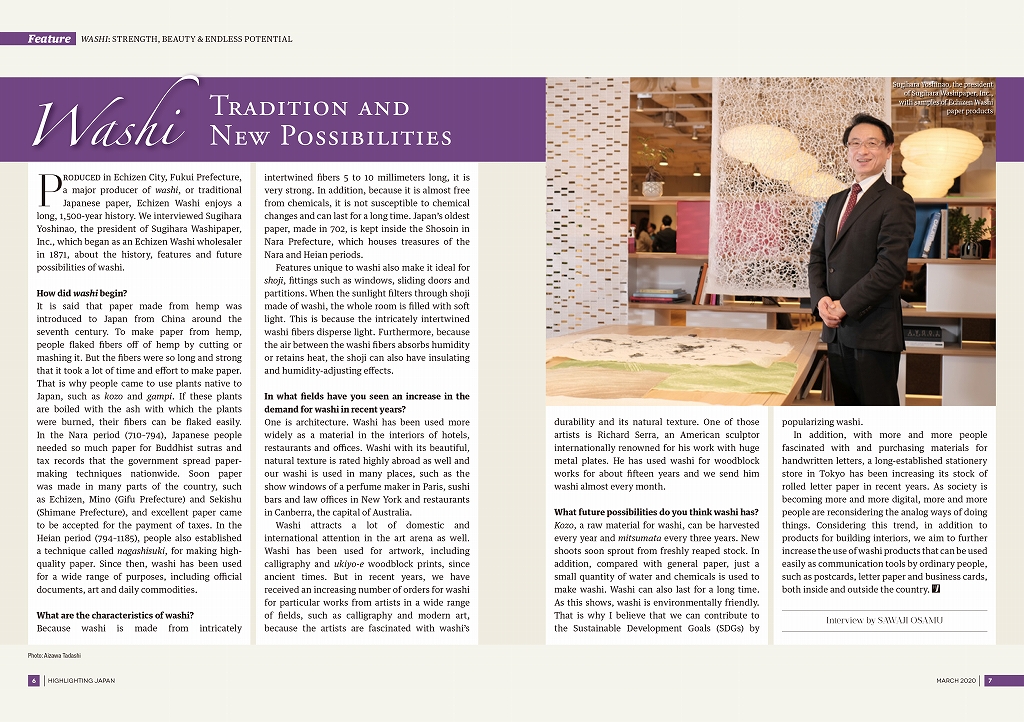Highlighting JAPAN 2020 March Interview
Washi: Tradition and New Possibilities
Produced in Echizen City, Fukui Prefecture, a major producer of washi, or
traditional Japanese paper, Echizen Washi enjoys a long, 1,500-year history.
We interviewed Sugihara Yoshinao, the president of Sugihara Washipaper, Inc.,
which began as an Echizen Washi wholesaler in 1871, about the history,
features and future possibilities of washi.
How did washi begin?
It is said that paper made from hemp was introduced to Japan from China
around the seventh century. To make paper from hemp, people flaked fibers
off of hemp by cutting or mashing it. But the fibers were so long and strong
that it took a lot of time and effort to make paper. That is why people came
to use plants native to Japan, such as kozo and gampi. If these plants are
boiled with the ash with which the plants were burned, their fibers can be
flaked easily. In the Nara period (710–794), Japanese people needed so much
paper for Buddhist sutras and tax records that the government spread
paper-making techniques nationwide. Soon paper was made in many parts
of the country, such as Echizen, Mino (Gifu Prefecture) and Sekishu (Shimane
Prefecture), and excellent paper came to be accepted for the payment of taxes.
In the Heian period (794–1185), people also established a technique called
nagashisuki, for making high-quality paper. Since then, washi has been used
for a wide range of purposes, including official documents, art and daily commodities.
What are the characteristics of washi?
Because washi is made from intricately intertwined fibers 5 to 10 millimeters
long, it is very strong. In addition, because it is almost free from chemicals,
it is not susceptible to chemical changes and can last for a long time.
Japan’s oldest paper, made in 702, is kept inside the Shosoin in Nara
Prefecture, which houses treasures of the Nara and Heian periods.
In addition, features unique to washi also make it ideal for shoji, sliding
paper doors, used in fittings, such as windows, doors and partitions.
When the sunlight filters through shoji made of washi, the whole room is
filled with soft light. This is because the intricately intertwined washi
fibers disperse light. Furthermore, because the air between the washi
fibers absorbs humidity or retains heat, the shoji can also have
insulating and humidity-adjusting effects.
In what fields have you seen an increase in the demand for washi in
recent years?
One is architecture. Washi has been used more widely as a material in the
interiors of hotels, restaurants and offices. Washi with its beautiful, natural
texture is rated highly abroad as well and our washi is used in many places,
such as the show windows of a perfume maker in Paris, sushi bars and law
offices in New York and restaurants in Canberra, the capital of Australia.
In addition, washi also attracts a lot of domestic and international attention
in the art arena as well. Washi has been used for artwork, including calligraphy
and ukiyo-e woodblock prints, since ancient times. But in recent years, we
have received an increasing number of orders for washi for particular works
from artists in a wide range of fields, such as calligraphy and modern art,
because the artists are fascinated with washi’s durability and its natural
texture. One of those artists is Richard Serra, an American sculptor
internationally renowned for his work with huge metal plates. He has used
washi for woodblock works for about fifteen years and we export washi
almost every month.
What future possibilities do you think washi has?
Kozo, a raw material for washi, can be harvested every year and mitsumata
every three years. New shoots soon sprout from freshly reaped stock.
In addition, compared with general paper, just a small quantity of water and
chemicals is used to make washi. Washi can also last for a long time.
As this shows, washi is environmentally friendly. That is why I believe that
we can contribute to the Sustainable Development Goals (SDGs) by
popularizing washi.
In addition, with more and more people fascinated with and purchasing
materials for handwritten letters, a long-established stationery store
in Tokyo has been increasing its stock of rolled letter paper in recent
years. As society is becoming more and more digital, more and more
people are reconsidering the analog ways of doing things. Considering
this trend, in addition to products for building interiors, we aim to further
increase the use of washi products that can be used easily as
communication tools by ordinary people, such as postcards, letter paper
and business cards, both inside and outside the country.
Interview by SAWAJI OSAMU |



